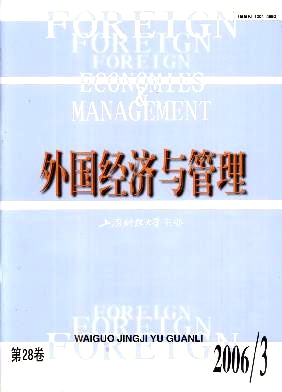零售商市场权力研究综述
外国经济与管理 2006 年 第 28 卷第 03 期, 页码:31 - 39
摘要
参考文献
摘要
零售商市场权力研究已成为渠道研究中的热点问题之一。本文通过对西方文献的系统扫描,在对市场权力进行界定的基础上,讨论了零售商掌握市场权力的表现及原因,回顾了零售商市场权力转移的相关实证研究,归纳了零售商市场权力对生产商、其他零售商和消费者的影响,并对零售商市场权力的未来发展进行了展望。
[1]Ailawadi,K L.The retail power-performance conundrum:what have we learned?[J].Journal of Retailing,2001,77:299-318.
[2]Ailawadi,K L,N Borin and P W Farris.Market power and performance:a cross-industry analysis of manufacturers and re-tailers[J].Journal of Retailing,1995,71(3):211-248.
[3](美)Anne T Coughlan,Anderson Erin,Stern Louis,EI-Ansary I Adel著;蒋青云等译.营销渠道(第6版)[M].北京:电子工业出版社,2003.
[4](英)McGoldrick P J著;裴亮等译.零售营销(原书第二版)[M].北京:机械工业出版社,2004.
[5]Boyle,Matthew.Brand killers[J].Fortune,2003-08-11:51-56.
[6]Blooma N Paul,Perryb G Vanessa.Retailer power and supplier welfare:the case of Wal-Mart[J].Journal of Retailing,2001,77:379-396.
[7]British Competition Commission.Supermarkets:a report on the supply of groceries from multiple stores in the UnitedKingdom[EB/OL].In:http://www.competition-commission.org.uk/rep_pub/reports/2000/446super.htm#full,2000.
[8]Cotterill,R W.The food distribution system of the future:convergence toward the US or UK model?[J].Agribusiness,1997,13(2):125-139.
[9]Cotterill,R W.Antitrust analysis of supermarket retailing:common global concerns that play out in local markets[EB/OL].In:http://www.fmpc.uconn.edu/publications/rr/rr88.pdf,February 10,2005.
[10]Derek Baker.The Danish food marketing chain:developments and policy choices[EB/OL].In:http://projectweb.sjfi.dk,September 2003.
[11]Digal N Larry and Ahmadi-Esfahani Z Fredoun.Market power analysis in the retail food industry:a survey of methods[J].The Australian Journal of Agricultural and Resource Economics,2002,46(4):559-584.
[12]Dobson W Paul.Exploiting buyer power:lessons from the British grocery trade[J].Antitrust Law Journal,2005,72(2):529-562.
[13]Elizabeth M M Q,Farina,Rubens Nunes,Guilherme F de A Monteiro.Supermarkets and their impacts on the agrifoodsystem of Brazil:the competition among retailers[J].Agribusiness,2005,21(2):133-147.
[14]Farris,P W,&Ailawadi,K L.Retail power:monster or mouse?[J].Journal of Retailing,1992,68(4):351-369.
[15]Fox A Mark.Market power in music retailing:the case of Wal-Mart[J].Popular Music and Society,2005,28(4):501-519.
[16]Frances,J and E Garnsey.Supermarkets and suppliers in the United Kingdom:system integration,information and con-trol[J].Accounting,Organizations and Society,1996,21(6):591-610.
[17]Jean-Fran ois Wen.Market power in grocery retailing:assessing the evidence for Canada[EB/OL].In:http://strate-gis.ic.gc.ca/SSI/ct/wen_e.pdf,September 25,2001.
[18]Messinger,P R,&Narasimhan,C.Has power shifted in the grocery channel?[J].Marketing Science,1995,14:189-223.
[19](美)Rosenbloom Bert;李乃和等译.营销渠道管理(原书第6版)[M].北京:机械工业出版社,2002.
[20]Mitchell,Alan.Why retailers’power has reached the tipping point[J].Marketing Week,2004,8(5):12-19.
①Digal等(2002)在一篇关于市场权力研究方法的论文中开篇就引用了这句话(Kohls L.Richard等,2002:270)。
②Blois在对Hingley(2005)一篇题名为《适应不平衡的渠道权力关系》的论文进行的评论中提出了这一观点(Blois,2005:859~862)。
③Boyle(2003)发现,像好事多(Costco)和沃尔玛这样的零售商正积极为创造自有品牌展开营销活动,部分自有品牌已经成为高档商品。某些消费品专家因此宣称:“要么争取成为店内销售额前三位的品牌,要么就退出市场。”
④零售商还可以通过出售或者有选择地与生产商分享销售信息来影响生产商。
⑤或者是直接通过陈列费和上架费,或者是通过作为进场条件的更低价格、类似于促销支持的广告费用。
⑥对权力的这一区分是该研究的一大亮点。后来,Kumar(2005:863~866)对此进行过相当详细的论述。
⑦在此基础上,Kinsey(1998)认为,实际上,沃尔玛现象是德姆塞茨假设(Demsetz hypothesis)的一个实例:有效率的企业具有高级管理技术或生产技术,从而能降低成本并获得较高的利润,进而增加市场份额和提高集中度。
⑧英国公平交易办公室(Office of Fair Trading)题为《零售业竞争》(Competition in Retailing)的报告(1997年9月)。
⑨Laoura M.Maratou等(2005)对此问题进行了研究,并在美国食品系统研究会(food system research group)主办的第二届研讨会(2005年6月16~17日)上报告了研究成果。
⑩该研究成果的摘要可通过以下网址获得:http://www.emich.edu/public/geo/557book/c312.stone.html。
[2]Ailawadi,K L,N Borin and P W Farris.Market power and performance:a cross-industry analysis of manufacturers and re-tailers[J].Journal of Retailing,1995,71(3):211-248.
[3](美)Anne T Coughlan,Anderson Erin,Stern Louis,EI-Ansary I Adel著;蒋青云等译.营销渠道(第6版)[M].北京:电子工业出版社,2003.
[4](英)McGoldrick P J著;裴亮等译.零售营销(原书第二版)[M].北京:机械工业出版社,2004.
[5]Boyle,Matthew.Brand killers[J].Fortune,2003-08-11:51-56.
[6]Blooma N Paul,Perryb G Vanessa.Retailer power and supplier welfare:the case of Wal-Mart[J].Journal of Retailing,2001,77:379-396.
[7]British Competition Commission.Supermarkets:a report on the supply of groceries from multiple stores in the UnitedKingdom[EB/OL].In:http://www.competition-commission.org.uk/rep_pub/reports/2000/446super.htm#full,2000.
[8]Cotterill,R W.The food distribution system of the future:convergence toward the US or UK model?[J].Agribusiness,1997,13(2):125-139.
[9]Cotterill,R W.Antitrust analysis of supermarket retailing:common global concerns that play out in local markets[EB/OL].In:http://www.fmpc.uconn.edu/publications/rr/rr88.pdf,February 10,2005.
[10]Derek Baker.The Danish food marketing chain:developments and policy choices[EB/OL].In:http://projectweb.sjfi.dk,September 2003.
[11]Digal N Larry and Ahmadi-Esfahani Z Fredoun.Market power analysis in the retail food industry:a survey of methods[J].The Australian Journal of Agricultural and Resource Economics,2002,46(4):559-584.
[12]Dobson W Paul.Exploiting buyer power:lessons from the British grocery trade[J].Antitrust Law Journal,2005,72(2):529-562.
[13]Elizabeth M M Q,Farina,Rubens Nunes,Guilherme F de A Monteiro.Supermarkets and their impacts on the agrifoodsystem of Brazil:the competition among retailers[J].Agribusiness,2005,21(2):133-147.
[14]Farris,P W,&Ailawadi,K L.Retail power:monster or mouse?[J].Journal of Retailing,1992,68(4):351-369.
[15]Fox A Mark.Market power in music retailing:the case of Wal-Mart[J].Popular Music and Society,2005,28(4):501-519.
[16]Frances,J and E Garnsey.Supermarkets and suppliers in the United Kingdom:system integration,information and con-trol[J].Accounting,Organizations and Society,1996,21(6):591-610.
[17]Jean-Fran ois Wen.Market power in grocery retailing:assessing the evidence for Canada[EB/OL].In:http://strate-gis.ic.gc.ca/SSI/ct/wen_e.pdf,September 25,2001.
[18]Messinger,P R,&Narasimhan,C.Has power shifted in the grocery channel?[J].Marketing Science,1995,14:189-223.
[19](美)Rosenbloom Bert;李乃和等译.营销渠道管理(原书第6版)[M].北京:机械工业出版社,2002.
[20]Mitchell,Alan.Why retailers’power has reached the tipping point[J].Marketing Week,2004,8(5):12-19.
①Digal等(2002)在一篇关于市场权力研究方法的论文中开篇就引用了这句话(Kohls L.Richard等,2002:270)。
②Blois在对Hingley(2005)一篇题名为《适应不平衡的渠道权力关系》的论文进行的评论中提出了这一观点(Blois,2005:859~862)。
③Boyle(2003)发现,像好事多(Costco)和沃尔玛这样的零售商正积极为创造自有品牌展开营销活动,部分自有品牌已经成为高档商品。某些消费品专家因此宣称:“要么争取成为店内销售额前三位的品牌,要么就退出市场。”
④零售商还可以通过出售或者有选择地与生产商分享销售信息来影响生产商。
⑤或者是直接通过陈列费和上架费,或者是通过作为进场条件的更低价格、类似于促销支持的广告费用。
⑥对权力的这一区分是该研究的一大亮点。后来,Kumar(2005:863~866)对此进行过相当详细的论述。
⑦在此基础上,Kinsey(1998)认为,实际上,沃尔玛现象是德姆塞茨假设(Demsetz hypothesis)的一个实例:有效率的企业具有高级管理技术或生产技术,从而能降低成本并获得较高的利润,进而增加市场份额和提高集中度。
⑧英国公平交易办公室(Office of Fair Trading)题为《零售业竞争》(Competition in Retailing)的报告(1997年9月)。
⑨Laoura M.Maratou等(2005)对此问题进行了研究,并在美国食品系统研究会(food system research group)主办的第二届研讨会(2005年6月16~17日)上报告了研究成果。
⑩该研究成果的摘要可通过以下网址获得:http://www.emich.edu/public/geo/557book/c312.stone.html。
引用本文
贺和平. 零售商市场权力研究综述[J]. 外国经济与管理, 2006, 28(3): 31–39.
导出参考文献,格式为:
下一篇:西方组织报复行为理论研究述评





 6581
6581  0
0

